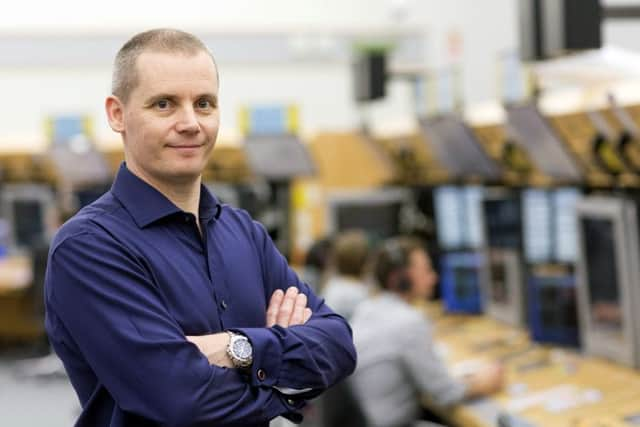In their own atmosphere: A look into Swanwick's Nats control centre


Featuring in a five-part series on BBC Two called Skies Above Britain, Nats Control Centre in Swanwick showcased the work of their highly-trained 735 controllers with cameras following their every move over a six-month basis.
The show aired its final episode on Wednesday.
It was a process that saw Brian Wheeler, operations supervisor at the centre, placed firmly under the microscope.


Advertisement
Hide AdAdvertisement
Hide AdHowever, he tells The News that the opportunity was one that Nats had been ‘very much interested in’.
He said: ‘We had been looking for a while about bringing the cameras in and giving people the chance to look behind the curtain and see what we really do.
‘I think there is a common misconception around air traffic controllers. People assume that we’re up in the control towers by airports but there’s actually hundreds of us behind the scenes in Swanwick looking after around 1,300 flight movements every day.
Mr Wheeler adds that contrary to popular belief there is no giant screen of the country with every flight mapped on it, although he would be partial to installing one.


Advertisement
Hide AdAdvertisement
Hide AdHe said: ‘I think films in the past have portrayed us in that way, almost as if the control rooms are full of people shouting and panicking, but when you go into the control rooms, it’s more of the polar opposite.
‘Of course, you hear our controllers chatting to pilots and other controllers, but it is more of a general hum, rather than the chaos that people are likely to be expecting.
‘We don’t have one giant screen but it’s definitely something I’d love to have but I just don’t think we’d have space at the moment.’
The centre is one of two in the UK, with Swanwick looking after the airspace for London and north up to Manchester, and Prestwick looking after the northern airspace including Manchester Airport.
Within Nats’ centre in Swanwick are two control rooms.
Advertisement
Hide AdAdvertisement
Hide AdThe London Area Control Centre’s (LACC) air traffic controllers monitor any flight above 21,000ft while the London Terminal Control Centre (LTCC) monitors any flights that are below that height.
The two centres are then divided up into Local Area Groups (LAGS) which are each led by a team leader, with each space looking after certain areas and busy airports such as Heathrow and Gatwick are each managed by their own LAG.
The room itself is crammed with monitors littering every corner, each lit up with a green map displaying the set airspace.
The maps on the monitors are a hive of green dots, that when zoomed in, display more than a hundred flights taking up southern airspace.
Advertisement
Hide AdAdvertisement
Hide AdThe job of the air traffic controller at LACC is to talk to the pilot once they enter the airspace and guide them out of the country, avoiding any other aircraft on the way before they hand them over to European air traffic controllers.
The job is similar for controllers at LTCC, only their job is to help the plane take off into available airspace and guide them down for landing once they descend past 20,000 feet.
‘It is quite a complex system that we have in place here,’ says Mr Wheeler.
‘I think the best way to describe it is as airborne chess.
‘You are dealing all with these pieces in the air and its all about mastering the art of how you manage them.’
Advertisement
Hide AdAdvertisement
Hide AdAs I walk through the impressive building with Mr Wheeler, he gives an idea of the scale that his team manages on a daily basis.
Most days, they monitor and look after 7,500 aircraft movements within the one building, with a big black board near the entrance showing employees how many flights have been handled so far and how many flights are in the air.
It’s only going to get busier, according to Mr Wheeler.
He said: ‘The aviation industry is climbing and climbing. There is so much space for it to grow.
‘About 20 years ago, flying was so expensive.
‘It was seen as a privilege for the few rather than an acceptance of the many.
Advertisement
Hide AdAdvertisement
Hide Ad‘These days, the rise of budget airlines has made it much easier for people to get anywhere.
‘Particularly in Europe, flying is seen as something which is mostly affordable.
‘You can get to Ireland for budget prices these days.’
While airlines continue to expand and more destinations open up, London’s air traffic is skyrocketing.
With Heathrow, Gatwick, Stansted, Luton and the City airport, the capital is engulfing the southern airspace in relentless air traffic.
Advertisement
Hide AdAdvertisement
Hide AdHeathrow itself handles more than 10 million passengers a year.
So, for the controllers that manage all these flights, how do they deal with the pressure?
‘The thing that makes being an air traffic controller so different to most jobs are the fact that we don’t have e-mails, we don’t have deadlines and you won’t have your boss chasing you about something.
‘Our controllers come in, do their shift, then leave their work here. They don’t take it home with them and that’s something which we know is extremely appealing.
Advertisement
Hide AdAdvertisement
Hide AdThe controllers work in shifts that see them monitor the country’s air traffic for two hours before taking a 30-minute break over the course of an eight hour shift.
Nats are on a serious recruitment drive and are hoping to bring through the next generation of controllers as their older employees look to retire.
So what does it take to be an air traffic controller?
‘It takes a few years of training where we take a look at how each trainee handles aptitude tests.
‘They are trained right here before taking their exams and then most of them stay on here for the rest of their careers. We have built our own family here.’
Advertisement
Hide AdAdvertisement
Hide AdCameras followed the controllers about routinely during the filming of the series, but to Mr Wheeler and others, they just became part of the furniture after a couple of weeks.
‘Of course, at first, it was quite tricky to get used to, having a camera in your face a lot.
‘But as time drew on, you would just see them each morning, sometimes as early as 6am and know that they are there just to carry out their job, just like we are.’
Mr Wheeler recalls a time early on during the filming in which after a period of relative calm, an emergency broke out with one of the flights and the cameras zoomed in, seeking to create intensity.
Advertisement
Hide AdAdvertisement
Hide Ad‘I remember that one aircraft went into an emergency and the producer came over and was asking we weren’t more panicked about it as the controller was just calmly talking the pilot through it,’ Mr Wheeler adds.
‘It seemed to me that they were struck by just how calm the controller was and once the situation was over, it was almost like there was a bit of a disappointment that wasn’t a bigger deal.
‘However, for me. I was delighted as it’s not our job to panic.
‘We’re there to do our job, not to cause panic.’